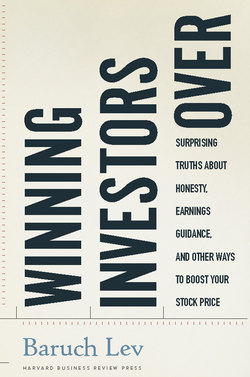Читать книгу Winning Investors Over - Baruch Lev - Страница 37
На сайте Литреса книга снята с продажи.
Why They Do It?
ОглавлениеWhy do managers manipulate financial information? There are numerous reasons for such a complex, widespread phenomenon. Enhancing managers’ compensation, which is frequently based on reported performance (earnings, sales) as well as on stock price changes—which in turn are affected by corporate performance—is a frequent manipulation motive.30 Others include thwarting proxy contests or activist shareholders by a pretense of improved performance; inflating share prices for larger takes at IPOs and secondary stock issues; avoiding violation of loan covenants; or deflecting regulatory (e.g., antitrust) interventions.31 The wide array of incentives to manipulate financial information as well as the items manipulated arise from the varied uses of this information in contractual arrangements between the company and its employees (to determine bonuses), lenders (loan covenant violations), patent licensees (royalty amounts), and other stakeholders.
But, as the cases show, the major objective of information manipulation is undoubtedly to obscure from investors the deterioration in the company’s operations or in its financial condition, thereby preserving managers’ jobs and reputations. Thus, Gateway embellished its reported revenues and earnings to conceal from investors the decline in demand for its computers after the tech bubble burst, and Coca-Cola aggressively pushed its concentrates on Japanese bottlers to mask the adverse effects of the intensified competition in the mid-1990s. Often, particularly companies in growth sectors (high-tech, biotech, environmental), manipulate reported information to preserve the image of the growth so coveted by investors. Thus, i2 Technologies, while growing reasonably well, front-loaded revenues to meet the increasingly aggressive growth expectations of analysts, and Charter Communications attempted to maintain the growth facade by refusing to disconnect delinquent and switching customers. My research on companies that restate their earnings corroborates the growth-at-all-costs objective. Restatements offer a unique opportunity to compare previously reported (misstated) earnings with true ones.32 A sample of 189 restating companies shows that the originally reported mean earnings growth rates in the two restated years were 3.8 percent and 6.7 percent, whereas the mean growth rates of the restated (true) earnings were rather anemic: 0.3 percent and 3.2 percent. Masking the end of growth is clearly the major objective of the manipulators.
This leaves us with a nagging question: don’t managers—on the whole, a smart lot—know that report manipulation is fraught with dangers (see next section) and is unsustainable, as the preceding cases show? How can rational persons engage in such a self-destructive activity? The answer probably lies in a prevalent cognitive trait of managers: overconfidence. Studies have shown that overconfidence—possessing unrealistically positive beliefs about the future performance of the company—is pervasive among executives, leading to both positive (increased investment in basic R & D) and negative (reckless acquisitions) outcomes.33 Here is the common scenario of report manipulation perpetrated by an overconfident manager:
The company’s operations hit a snag: sales growth flattens or operating costs unexpectedly increase. To avoid missing the consensus or their own guidance, managers front-load or bring forward a modest amount of revenue from next quarter to make the numbers. They, of course, know that next quarter’s revenue will start with a deficit, but here is where overconfidence comes in. Managers are convinced that revenues in the next quarter or year will be sufficiently high to cover the front-loading and then some. It rarely is, however, and small frauds quickly mushroom and burst. This was vividly confirmed by the CEO of Satyam, a large Indian information services company, who in his 2009 letter to the board disclosing the massive manipulation that he perpetrated over several years wrote: “What started as a marginal gap between actual operating profit and the one reflected in the books of accounts [and publicly reported] continued to grow over the years. It has attained unmanageable proportions.”34
